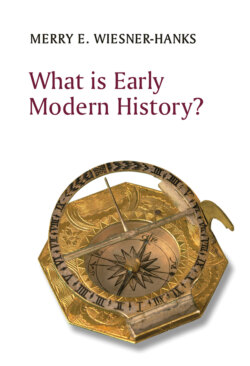What is Early Modern History?

Реклама. ООО «ЛитРес», ИНН: 7719571260.
Оглавление
Merry E. Wiesner-Hanks. What is Early Modern History?
Table of Contents
Guide
Pages
Series Title. What is History? series
What is Early Modern History?
Copyright Page
Introduction
Creating “early modern”
Disputing “early modern”
Aims and structure of the book
Notes
1 Economic and Social History
Economic history
Social history
Notes
2 Religious, Intellectual, and Cultural History
Religious history
Intellectual history
Cultural history
Notes
3 Women’s, Gender, and Sexuality Studies
Women
Gender
Sexuality
Notes
4 The Atlantic World
Explorations and exchanges
Colonization and creolization
Political developments and the Atlantic revolutions
Notes
5 The Global Early Modern
Interactions
Warfare and military history
The environment and environmental history
Notes
6 Popular and Public History
Popular history
Public history
Notes
Afterword: The Future of Early Modern History/Studies
Notes
Further Reading
Introduction
1 Economic and Social History
2 Religious, Intellectual, and Cultural History
3 Women’s, Gender, and Sexuality Studies
4 The Atlantic World
5 The Global Early Modern
Index
POLITY END USER LICENSE AGREEMENT
Отрывок из книги
Merry E. Wiesner-Hanks
Writers in the sixteenth and seventeenth centuries increasingly used the word “middle” – middle season, middle centuries, middle age – to describe the period between the fall of ancient Rome and their own era. Following Bruni, they divided European history into three parts: ancient (to the end of the Roman Empire in the West in the fifth century); medieval, a word that comes from medium aevum, Latin for middle age (from the fifth century to the fifteenth); and what they usually called “new” (novum in Latin, from the fifteenth century forward). This three-part division became extremely influential, and is still in use today to organize course offerings, library and bookstore holdings, museums, and even how people think of themselves. On introducing themselves at a conference, scholars often say, “I’m a medievalist” or “I’m an ancient historian.”
.....
Map 1: Europe in 1450
The end of the early modern era tends to vary by discipline. In literature, especially in the English literature that dominates the field, it is generally set at around 1700. In history, it is almost always 1789 or 1800. The former date, that of the French Revolution, privileges the political history of western Europe, though there were other significant changes in the decade: Edmund Cartwright invented the steam-powered loom and opened the first cloth-making factory using his new machines, and the first fleet of convicts set sail from Britain to Australia, carrying about a thousand people. Thus the 1780s saw new processes in industrialization and colonization, two developments that are markers in most literature of the break between “early modern” and what we might call “truly modern.” In his influential The Birth of the Modern World, 1780–1914, for example, Christopher Bayly begins with that decade.9 But 1800 works just as well to mark this break, and is widely used.
.....